|
Anatomie du coccyx
Anatomy of the coccyx
|
 Visit our special pages
on coccydynia and dynamic X-rays Visit our special pages
on coccydynia and dynamic X-rays

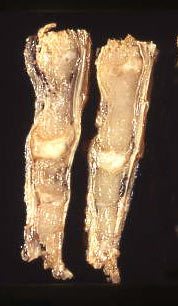 |
 Vus en coupe, les
disques intercoccygiens sont assez épais. Ils n'autorisent qu'une faible
mobilité. Vus en coupe, les
disques intercoccygiens sont assez épais. Ils n'autorisent qu'une faible
mobilité.
 On a lateral view, the
intercoccygeal discs are thick. They only allow a limited mobility. On a lateral view, the
intercoccygeal discs are thick. They only allow a limited mobility. |
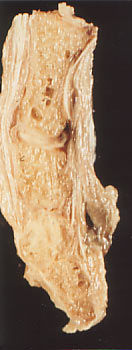 |
 Dans d'autres cas, il
n'y a pas de disque mais une articulation de type synovial, avec un
revêtement de cartilage, qui permet une mobilité plus importante. Notre
impression (J-Y Maigne) est que ce type d'articulation est plus
fréquement rencontrée chez les patients souffrant de coccygodynie que
chez des sujets sains. La raison serait qu'une mobilité plus marquée est
une source d'usure. Dans d'autres cas, il
n'y a pas de disque mais une articulation de type synovial, avec un
revêtement de cartilage, qui permet une mobilité plus importante. Notre
impression (J-Y Maigne) est que ce type d'articulation est plus
fréquement rencontrée chez les patients souffrant de coccygodynie que
chez des sujets sains. La raison serait qu'une mobilité plus marquée est
une source d'usure.
 In other cases, there
is no disc but a synovial joint with a cartilage coating, which allows a
more important mobility. Our feeling (J-Y Maigne) is that this form of
joint is more frequently encountered in patients with coccydynia than in
healthy persons. The reason would be that a more pronounced mobility is
a source of lesion. In other cases, there
is no disc but a synovial joint with a cartilage coating, which allows a
more important mobility. Our feeling (J-Y Maigne) is that this form of
joint is more frequently encountered in patients with coccydynia than in
healthy persons. The reason would be that a more pronounced mobility is
a source of lesion. |
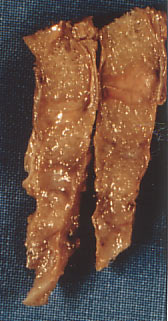 |
 Une découverte
intéressante de nos dissections était que dans certains cas,
l'articulation était une structure intermédiaire entre disque et
articulation synoviale. Plus précisement, il y avait une fente intra-discale
bordée de cellules synoviales, bien visible sur cet échantillon. Une
question vient immédiatement à l'esprit : le type d'articulation (discale,
intermédiaire ou synoviale) est il déterminé à vie chez un individu
donné, ou bien y a t'il un changement continu et progressif du disque
chez le plus jeune à une articulation synoviale chez le plus âgé, via
l'apparition d'une fente qui vient séparer le disque ? Un tel phénomène
existe au niveau du disque cervical. Une découverte
intéressante de nos dissections était que dans certains cas,
l'articulation était une structure intermédiaire entre disque et
articulation synoviale. Plus précisement, il y avait une fente intra-discale
bordée de cellules synoviales, bien visible sur cet échantillon. Une
question vient immédiatement à l'esprit : le type d'articulation (discale,
intermédiaire ou synoviale) est il déterminé à vie chez un individu
donné, ou bien y a t'il un changement continu et progressif du disque
chez le plus jeune à une articulation synoviale chez le plus âgé, via
l'apparition d'une fente qui vient séparer le disque ? Un tel phénomène
existe au niveau du disque cervical.
 An interesting finding
in our dissections was that some joints were an intermediate structure
between a disc and a synovial joint. More precisely, there was a
intradiscal cleft bordered by synovial cells. This is well visible on
this sample, on the upper disc. A question arises immediately: is the
type of joint (disc, intermediate or synovial) determined for life in a
given person, or is there a continuous and progressive change from a
disc in the younger to a synovial joint in the elder, via the apparition
of a cleft which separates the disc? Such a phenomenon does exist in the
cervical disc. An interesting finding
in our dissections was that some joints were an intermediate structure
between a disc and a synovial joint. More precisely, there was a
intradiscal cleft bordered by synovial cells. This is well visible on
this sample, on the upper disc. A question arises immediately: is the
type of joint (disc, intermediate or synovial) determined for life in a
given person, or is there a continuous and progressive change from a
disc in the younger to a synovial joint in the elder, via the apparition
of a cleft which separates the disc? Such a phenomenon does exist in the
cervical disc. |
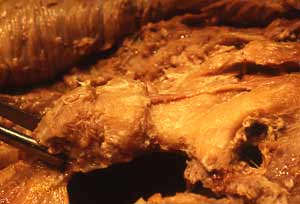 |
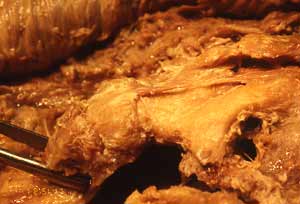 |
 Vue latérale droite.
Une articulation synoviale permet une plus grande mobilité en flexion
extension Vue latérale droite.
Une articulation synoviale permet une plus grande mobilité en flexion
extension |
 Right lateral view. A
synovial joint allows a greater mobility in flexion extension Right lateral view. A
synovial joint allows a greater mobility in flexion extension
|
|
Publications sur la coccygodynie disponibles sur le site
Publications on coccydynia on this website
|
|
|
|
